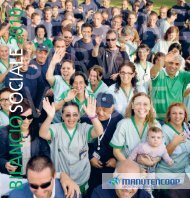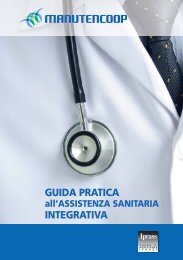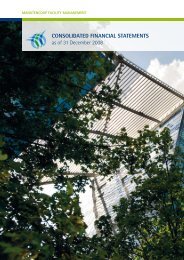Financial Statements 2009 - Manutencoop
Financial Statements 2009 - Manutencoop
Financial Statements 2009 - Manutencoop
You also want an ePaper? Increase the reach of your titles
YUMPU automatically turns print PDFs into web optimized ePapers that Google loves.
IAS 38 – Intangible Assets: the revision to IFRS 3 in 2008 established that there is sufficientinformation to measure the fair value of an intangible asset acquired as part of a businesscombination if such asset is separable or originates from contractual or legal rights. IAS 38 hasbeen amended as a consequence to reflect this change to IFRS 3. The amendment also clarifiedthe techniques to be used normally when measuring the fair value of intangible assets for whichthere is no active reference market. In particular, these techniques include, as alternatives,estimation of the discounted net cash flows deriving from the assets, estimation of the costsavoided by the entity due to ownership of the assets rather than having to use them underlicence from a third party, and estimation of the costs necessary to re-create or replace them(application of the cost method). This amendment must be applied on a prospective basis from1 January 2010.> IAS 39 – <strong>Financial</strong> Instruments: Recognition and Measurement: this amendment restrictsthe inapplicability exception contained in para. 2(g) of IAS 39 to forward contracts betweena purchaser and a selling owner for the purpose of selling an entity transferred under abusiness combination at a future acquisition date, on condition that completion of the businesscombination does not depend on further action by one of the two parties, but solely on thepassage of an appropriate period of time. The amendment clarifies, by contrast, that IAS 39does apply to option contracts (whether or not currently exercisable) that allow one of the twoparties to control whether or not future events take place and whose exercise would resultin control over the entity. The amendment also clarifies that implicit penalties for the earlyrepayment of loans, being the price that compensates the lender for the loss of further interest,are deemed to be closely correlated with the loan contract that envisages them and, accordingly,must not be recognised separately. Lastly, the amendment clarifies that profits and losses on ahedged financial instrument must be reclassified from equity to the income statement in theperiod in which the hedged expected cash flow has an effect on the income statement. Thisamendment must be applied on a prospective basis from 1 January 2010.> IFRIC 9 – Reassessment of embedded derivatives: this amendment, which must be appliedon a prospective basis from 1 January 2010, excludes from the application of IFRIC 9 thederivatives embedded in contracts acquired as part of business combinations at the time offorming entities under common control or joint ventures.On 8 October <strong>2009</strong>, the IASB issued an amendment to IAS 32 – <strong>Financial</strong> Instruments:Presentation: Classification of Rights Issues, governing the recognition of rights issues (rights,options or warrants) not denominated in the issuer's functional currency. Previously, such rightswere recognised as liabilities from derivatives; the amendment, on the other hand, requires (oncertain conditions) such rights to be recognised in equity regardless of the currency in which theexercise price is denominated.This amendment is applicable on a retrospective basis from 1 January 2011. Adoption of thisamendment is not expected to have any effect on the Company's financial statements.On 4 November <strong>2009</strong>, the IASB issued a revised version of IAS 24 – Related Party Disclosures whichsimplifies the type of information required about transactions with related parties controlled bythe State and clarifies the definition of related parties. The standard is applicable from 1 January2011; at the reporting date, the competent bodies within the European Union have not yetcompleted the endorsement process necessary for its application.On 12 November <strong>2009</strong>, the IASB published the first chapters of IFRS 9 – <strong>Financial</strong> Instrumentson the classification and measurement of financial assets from 1 January 2013. This publicationis the first part of a process in phases that will completely replace IAS 39. The new standardadopts a unified approach, determining the appropriate measurement criterion based on the waythat financial instruments are managed and on the characteristics of the contractual cash flowsderiving from the financial assets, thus replacing the various rules envisaged in IAS 39. In addition,the new standard envisages just one way to determine the impairment of financial assets. At thereporting date, the competent bodies within the European Union have not yet completed theendorsement process necessary for the application of the new standard.On 26 November <strong>2009</strong>, the IASB issued a minor amendment to IFRIC 14 – concerning voluntaryprepayments against minimum required contributions, allowing entities that make suchprepayments to recognise them as an asset. The amendment is applicable from 1 January 2011;at the reporting date, the competent bodies within the European Union have not yet completedthe endorsement process necessary for its application.In June <strong>2009</strong>, the IASB issued an amendment to IFRS 2 – Share-based Payment - Group CashsettledShare-based Payment Transactions. This amendment clarifies the scope of application ofIFRS 2 and its relations with other accounting standards. In particular, it clarifies that entitiesthat receive goods or services as part of a share-based payment plan must record such goodsand services regardless of which Group company settles the transaction, and without regardfor whether settlement is made in cash or using shares; in addition, it establishes that the word“Group” has the meaning given in IAS 27 – Consolidated and Separate <strong>Financial</strong> <strong>Statements</strong>i.e. it includes the parent company and its subsidiaries. The amendment further specifies thatan entity must measure from its own standpoint the goods or services received as part of atransaction settled in cash or using shares, which might not coincide with that of the Group orwith the related amount recognised in the consolidated financial statements. The amendmentincorporates the guidelines previously included in IFRIC 8 - Scope of IFRS 2 and in IFRIC 11 - IFRS2 - Group and Treasury Share Transactions. As a consequence, the IASB has withdrawn IFRIC8 and IFRIC 11. This amendment is applicable from 1 January 2010; at the reporting date, thecompetent bodies within the European Union have not yet completed the endorsement processnecessary for its application.On 26 November <strong>2009</strong>, IFRIC issued IFRIC 19 – Extinguishing <strong>Financial</strong> Liabilities with EquityInstruments, which provides guidelines for the recognition of such transactions. This interpretationestablishes that if an entity renegotiates the conditions for extinguishing a financial liability andthe creditor agrees to extinguish it via the issue of shares in the entity, then the shares issuedbecome part of the price paid to extinguish the financial liability and must be measured at fairvalue; the difference between the carrying amount of the extinguished financial liability and theinitial value of the equity instruments issued must be recognised in the income statement for theperiod.The amendment is applicable from 1 January 2011; at the reporting date, the competent bodieswithin the European Union have not yet completed the endorsement process necessary for itsapplication.Adoption of the consistency principle for recognising the combination of businessesunder common control.On 22 December <strong>2009</strong> with effect from 31 December <strong>2009</strong>, <strong>Manutencoop</strong> Facility ManagementS.p.A. contributed to <strong>Manutencoop</strong> Costruzioni S.p.A. the line of business relating to the design,construction and maintenance of building works for public and private customers, in order tooptimise the use of resources and contain costs by rationalising the organisational structure.46 - financial statements as of 31 December <strong>2009</strong> - principles and explanatory notes <strong>Financial</strong> statements as of 31 December <strong>2009</strong> - principles and explanatory notes - 47








